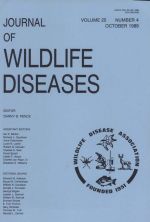Prior to a limited field application of an orally-administered vaccinia-rabies glycoprotein (V-RG) recombinant virus vaccine for wildlife, background data were obtained for the proposed site on Parramore Island, Virginia (USA). Mammalian target and nontarget species, potentially at risk for exposure to vaccine were inventoried. Placebo baiting trials with a fishmeal polymer bait resulted in high bait disturbance (88 to 100%), primarily by raccoons (Procyon lotor), with infrequent visitation and no evidence of bait consumption by deer (Odocoileus virginianus), small mammals or avian species. Definitive bait acceptance rates by raccoons (indicative of bait ingestion) were difficult to accurately determine based exclusively on premolar and vibrissae samples collected antemortem from live-trapped raccoons for tetracycline and rhodamine B biomarker analyses, respectively. Bait acceptance rate was more accurately determined during a pilot baiting trial conducted on North Island, South Carolina, when mandibles (postmortem samples) were examined for tetracycline incorporation. Parasitologic findings in raccoons on Parramore Island included Hepatozoan procyonis, Phagicola angrense and Physaloptera rata and a variety of incidental microscopic lesions, and provided baseline pathological data for comparison subsequent to V-RG vaccine application. A population density estimate of one raccoon/2.7 ha was calculated using mark–recapture data for comparison after vaccine deployment. Limited reproductive data, including estimates of pregnancy rates by palpation, the number of live kits/litter live-trapped with previously pregnant raccoons or observed in the dens of radio-collared raccoons, was gathered to assess the effect of proposed oral vaccination with V-RG vaccine. Home ranges were assessed by radio-telemetry of 15 raccoons; all radio-collared raccoons currently reside on Parramore Island. Longest straight line distance travelled by raccoons was <2 km, except when animals were translocated and were found to return to their original range.
How to translate text using browser tools
1 October 1989
PROPOSED FIELD EVALUATION OF A RABIES RECOMBINANT VACCINE FOR RACCOONS (PROCYON LOTOR): SITE SELECTION, TARGET SPECIES CHARACTERISTICS, AND PLACEBO BAITING TRIALS
Cathleen L. Hanlon,
Donald E. Hayes,
Amir N. Hamir,
Daniel E. Snyder,
Suzanne Jenkins,
Charles P. Hable,
Charles E. Rupprecht

Journal of Wildlife Diseases
Vol. 25 • No. 4
October 1989
Vol. 25 • No. 4
October 1989
bait
biomarker
oral vaccination
parasitologic survey
Procyon lotor
rabies
raccoon




